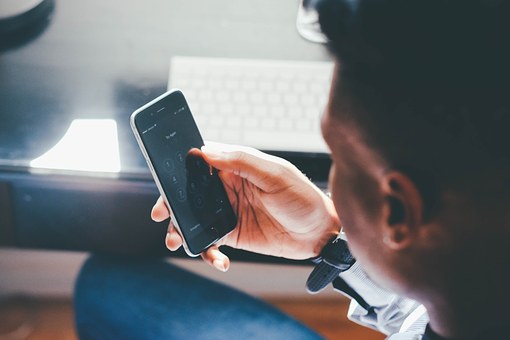You can read my blog or watch my you tube channel on today’s topic of screen time and vision. Click here for the you tube version.
Most patients that I help are40+ and trying to be active and enjoy life. I am also in that category. Besides physical and mental function, I also want to have my vision intact for next 20-30 years plus. I am willing to bet that even if you are ok with most aging processes that you don’t want to have permanent vision loss in your 60s-70s? So today I’m going to tackle the issue of aging macular degeneration (AMD). Why is a physical therapist talking about AMD? Well, many of my patients come to see me for neck and back pain from sitting and using laptops, tablets,and smart phones. We do see more people with degenerative changes in their spines due to the amount of sitting and the increased neck bending/flexion from holding devices and looking down for prolonged periods. American adults spend an average of 11 hours a day on screen time. These devices give off blue light that has been found to damage the cells in the back of the retina leading to permanent vision loss from AMD.
AMD is the leading cause of vision loss. It affects more than 10 million people. It’s mainly associated with aging, but some forms of macular degeneration affect younger people as well. I don’t know about you, but as someone who must use a computer for part of my occupation and using my phone for communication I don’t see my screen time going down. (However, it’s not 11 hours a day!) So, is all blue light bad for you? Why not block all blue light, all the time? Bad idea. It’s well documented that some blue light exposure is essential for good health. Research has shown that high energy visible light boosts alertness, helps memory and cognitive function and elevates mood. In fact, something called light therapy uses bright white light that has a significant amount of blue light to treat seasonal affective disorder (SAD). Also, blue light is very important in regulating circadian rhythm – the body’s natural wakefulness and sleep cycle.Too much blue light at night (reading a novel on a tablet or e-reader at bedtime for example) can disrupt this cycle, potentially causing sleepless nights and daytime fatigue. (Reading in bed is also a bad thing for your posture, especially your neck and back! Don’t do it anymore!)
What can you do to give yourself the best protection against permanent vision loss?
1. You can get filters on your devices and wear glasses that filter blue light.
2. Antioxidants and supplements:The National Institute of Eye Health conducted 2 very large studies that found supplements do help protect the retina against blue light. In fact the supplement dosages recommended for eye health can’t be obtained from diet alone!
Which Supplements for eye health based on the literature?
1. Lutein and Zeaxanthin(antioxidants)
2. B Vitamins (Harvard states that only a fraction of U.S. adults currently get the recommended daily intake of all B vitamins from diet alone)
3. Omega-3 fatty acids: DHA and EPA
4. Zinc (powerful antioxidant) andCopper
5. Vitamin C and E (antioxidants)
6. Selenium (helps you absorb Vitamin E)
Many Optometrists and Opthamologists across the country are starting to use this Nobel Prize winning biophotonic scanner technology in their officers to help identify patients quickly and easily that need to increase their antioxidant levels. Providers of all disciplines are recognizing we need away to identify if your nutritional plan is working and work more on prevention and wellness vs only treating disease (when it is too late). If you want to make sure you are doing everything you can for prevention and wellness, then call us on the number below to schedule your scan. Or you can email me if you have any more questions. See you next week with more healthy tip.
Healthy, energy-packed, peanut butter and banana oatmeal
I promised you a warm and cozy breakfast idea, and I delivered! Every meal can be an antioxidant powerhouse, there are no excuses right?! Why not start your day PACKED with goodness? Oatmeal is a blank canvas, you can make it whatever you want. Today we’re going to go classic with peanut butter and banana, with a blueberry twist. Like a PB&J! Start every morning with your glass of water, then dive into this bowl of pure bliss and you’ll be good to go all morning! Let’s hear about the benefits:
Oats are among the healthiest grains on earth.
They’re a gluten-free whole grain and a great source of important vitamins, minerals, fiber and ANTIOXIDANTS!
Studies show that oats and oatmeal have many health benefits. These include weight loss, lower blood sugar levels and a reduced risk of heart disease.
The nutrient composition of oats is well-balanced.
They are a good source of carbs and fiber, including the powerful fiber beta-glucan.
They also contain more protein and fat than most grains.
Oats are loaded with important vitamins, minerals and antioxidant plant compounds. Half a cup (78 grams) of dry oats contains:
- Manganese: 191% of the RDI
- Phosphorus: 41% of the RDI
- Magnesium: 34% of the RDI
- Copper: 24% of the RDI
- Iron: 20% of the RDI
- Zinc: 20% of the RDI
- Folate: 11% of the RDI
- Vitamin B1 (thiamin): 39% of the RDI
- Vitamin B5 (pantothenic acid): 10% of the RDI
- Smaller amounts of calcium, potassium, vitamin B6 (pyridoxine) and vitamin B3 (niacin)
Ingredients
- 1 cup water
- 1/2 cup organic rolled oats
- 1 tbsp chia seeds
- 1 cup frozen wild blueberries
- 1 banana, diced
- 1/2 tsp ground ginger & cinnamon (optional)
- 1/4 tsp sea salt
- 2 tbsp organic natural peanut butter* (no salt, oil or sugar)
Instructions
- Bring the water to a boil in a pot, then reduce to a simmer and stir in all of the ingredients except for the peanut butter.
- Cook for 3-4 minutes, stirring frequently to prevent them from sticking to the pot. Add a little extra water if needed to adjust thickness.
- Remove from heat and let rest for 5 minutes.
- Scoop the oatmeal into a bowl and top with the peanut butter. Drizzle with a little plant-based milk if desired and enjoy.
*notes: If you have an allergy to peanut butter, or you just don’t like it, use raw, organic almond butter, raw cashew butter or raw sunflower butter. Tahini is good too, but you may need to add a sweetener, such as maple syrup to taste. If you like your oats a bit creamier, replace water with a plant milk such as, unsweetened vanilla almond, coconut, cashew or rice milk.
Recipe from our resident vegan foodie, Sarah Burns







